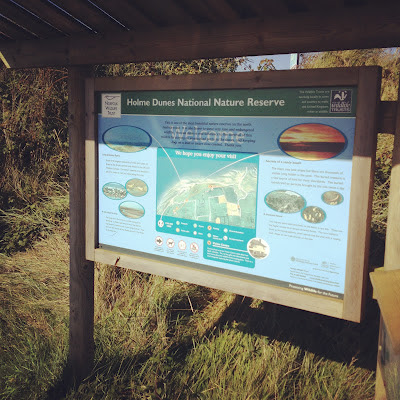Not sure when the American phrase 'Jaywalking' came into existence but it should now be called Jay-flying and be attributed to Norfolk. There has been a huge influx of
Jays across the county and my brother Ant and I saw it first hand as we stopped in Hunstanton for a hot sausage roll breakfast. We witnessed squadrons of Jays passing overhead as we headed for Holme Dunes at the start of our epic weekend of birdwatching on the North Norfolk coast.
 |
| Holme Dunes NNR (just as it says on the picture) |
Normally this time of year heralds the right migratory winds from the east that would make any birdwatcher salivate at the prospect of the rarities in abundance falling at their feet. Not this weekend though. With a very light North Westerly, things were quiet on the land and on the sea. Nice day for a stroll though.
There were a few wader species on the beach.
Knot, Turnstone, Sanderling, Black-tailed Godwit, Redshank and
Oystercatcher all allows close viewing with only the occasional dog walker or weekend walker sending the flocks into the air. Don’t think these people even noticed them.
 |
| Knot with a dodgy wing |
We noticed in the distance a
Great Skua sitting on the beach. We got as close as we could to view it as they don’t often come to shore, usually seen attacking gulls and terns for food. These birds are the pirates of the sea.
 |
| Great Skua |
 |
| Great Skua |
On the sea,
Gannets flew east and we had one late
Sandwich Tern heading west other than that, with virtually no wind, there wasn’t much to see. The pine wood by the observatory wasn’t a lot better. The usual
Coal Tits – which I missed and
Goldcrest flitted about high in the trees making bird watching a pain in the neck. Skeins of
Pink-footed Geese came in waves across the sky and a few
Swallows flew low over the dunes preparing for that long journey south. From the hides only
Little Grebe, Wigeon, Teal and
Shoveler were noted and a
Kestrel stood guard outside,
 |
| Common Darter. Yes there are two of them. |
Dragonflies are starting to really interest me. I’m pretty new to this game but when the birds go a bit quiet in the summer, the dragonfly may just take centre stage. This is a
Common Darter in a well, compromising position known apparently as a copulation circle. Look that up on the web at your peril.
 |
| Kestrel |
On leaving Holme I had to be careful not to destroy the underside of the car as the number of sleeping policemen made travelling the entrance road like piloting a trawler in high winds. Did I say high winds...I wish.
Our next port of call ( like the link?) was Titchwell. You can’t go wrong with Titchwell; it always has good birds. The car park was heaving and this was a good sign. Ant and I walked through to the picnic area and it was full of pointing birders with huge camera lenses. The excitement wasn’t for a Red-flanked Bluetail although you’d think it was but it was a female
Pied Flycatcher. Hey ho, beggars can’t be choosers. It was a great bird though but it wouldn’t sit still for my digiscoping lack of dexterity.
Curlews on the other hand do sit still. Well this one did anyway. It makes a big difference when the buggers stay still I can tell you.
 |
| Curlew |
Another perfect example of how to pose came from a
Bar-tailed Godwit. This one was a cracking bird, feeding on the saltmarsh. Overhead more
Pink-footed Geese came in for the winter along with wave after wave of
Brent Geese. Norfolk is one of the best places in the UK for watching geese and today was no exception.
 |
| Bar-tailed Godwit |
We made our way to the foreshore hoping for some better sea-watching but we were wrong. Sure, there were waders on the breakwater and some distant
Gannets, Auks and Geese but nothing special.
 |
| Ant looking for birds but thinking about beer. |
We heard a 'probable' Blyth’s Reed Warbler had been seen nesr the Fen Hide so we went there for a while. Nothing showed but this gave us the chance to check out the new trails at Titchwell and these led us to four Greenshank on the freshwater marsh. Probably time for a beer.
If we thought trying to find good birds was difficult, you should have seen us trying to find our apartment. yes, apartment. We are posh birders didn’t you know? We were booked into the Langham Upper apartment at Langham Hall, spookily enough in Langham. Now Langham we could find. It has one pub, about 10 houses and no shops that we could see. The pub closed at 3pm and reopened at 7pm (remember those days?) But we couldn’t find this Langham Hall anywhere. We asked an ASBO urchin with a pitbull and he directed us to a Hall right in front of our eyes. No wonder we hadn’t seen many birds so far. Even then when we were there, we, I mean I still couldn’t find the actual Upper Apartment where we were suppose to stay. Look we found it eventually and it was fine. A spiral staircase, lounge, kitchen, two bedrooms and a bathroom with a crap shower and no soap. On the plus side, it had a few jigsaw puzzles, a few shit CDs and a couple of DVDs without a DVD player. What more could you ask for? We dined in the King’s Arms in Blakeney which was great. Good food and beer and a lot of screaming women. Don’t think it was because of us though, think they were just merry. We heard a Tawny Owl when we got back to our pad.
Sunday morning came and the whole of Langham was smothered in fog. Things were looking promising. The influx of Jays continued and after a hearty breakfast of bacon and eggs we set out for Wells Wood at Wells-next-the-sea.
 |
| Wells Wood |
We had a great start with a pair of
Bullfinch and a few
Brambling up in some silver birch. Three
Redwing and a couple of Song Thrush appeared as we headed for The Dell. The Dell is a deep dip in the woods that attracts autumn migrants like Yellow-browed Warblers, Firecrest and Red-breasted Flycatchers....and Magpies. We saw
Magpies and Jays with a few
Goldcrest and
Coal Tits but that was it. We came out of the wood and Ant found a
Marsh Harrier quartering the grazing marsh. A
Great Spotted Woodpecker flew over.
We then tried to find Kelling Water Meadow for a Pectoral Sandpiper but again I failed. We gave up and went to Cley. You know where you are with Cley. A few
Egyptian Geese were seen just before the reserve and from East Bank, we found a few
Bearded Tit but they would play ball for the camera.
 |
| Cley next-the-sea with windmill but little wind. |
Sea-watching was better with
Common Gull, Guillemot, Red-throated Divers, Common Scoters and
Gannets feeding close to shore.
 |
| Common Gull |
 |
| Guillemot |
 |
| Ant thinking he had found a barrel of Woodforde’s Nelson’s Revenge bobbing on the sea |
We walked the circular path from East to West Bank, popping into the hides as we went. We added to our bird total with
Common Buzzard, soaring high over Walsey Hills. Walsey Hill would be our final stop.
 |
| Wigeon |
Walsey Hills is a reserve that specialises in migrants. less than half a mile from the sea, the reserve is a dense vegetated hill that acts as a magnet to tired migrant travellers. I know one thing, we were tired and we had about an hour of energy left but it was worth the effort. A
Cetti’s Warbler showed well. These skulking shy warblers are always heard but rarely seen. We got good views here. On the feeders,
Lesser Redpoll, Coal Tit and
Great Tit visited often and a
Chiffchaff got our migrant warbler hopes up. Alas, that was all we saw from the path.
 |
| Coal Tit |
 |
| Lesser Redpolls |
The path leads out onto farmland where loads of crows and pheasants sat on the rolled bales of hay. In the field though, we found a number of
Red-legged Partridge that gave us a grand total of 91 species for the trip.
 |
| Red-legged Partridge |
I can’t help thinking that if the wind had been anything like an easterly or a northerly one, that total would have been over the 100 mark. Maybe next time





















Comments
Post a Comment